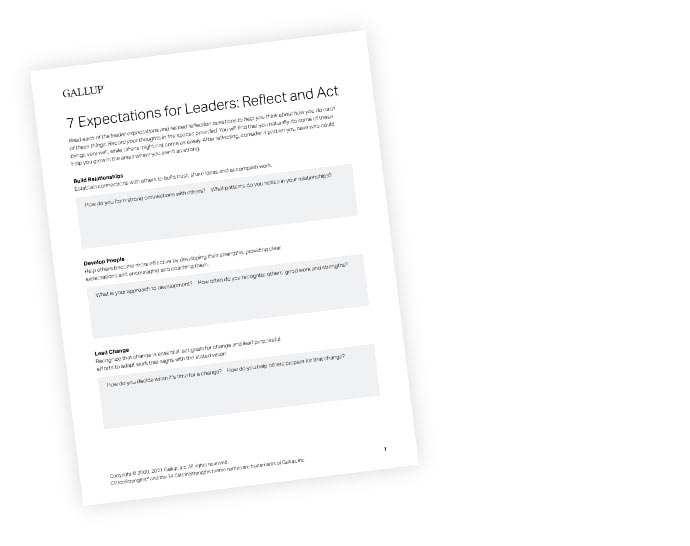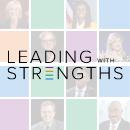
Effective Leadership: What Makes a Good Leader
Introduction
Introduction
There may not be an "I" in team, but there is an "I" in disengaged.
What does this have to do with leadership and development? Well, regardless of what, why and where you lead, you — as the leader — are directly responsible for the engagement of those who follow you.
And engagement is supported by your culture, which you are also responsible for as a leader. This is why it's vital for leaders to set the right tone for the organization — for the sake of engagement, culture and the employee experience.
Whether you're leading a family, a class or a corporation, good leadership means inspiring others to achieve certain outcomes. And it's up to you to decide whether you are leading positively or negatively — and whether you choose to focus on engagement or merely output.

"Improving your leadership begins with a focus on improving what you're already good at."
Leadership can often be equal parts high confidence and self-esteem and worrying if you're doing it right while continually searching for answers. Whether you're a leader in an organizational setting or have high influence in some other capacity, improving your leadership begins with a focus on what you're already good at.
We would call that leading with your strengths: the things that come naturally to you and that help you succeed daily. When you intentionally apply your strengths as a leader, that's when your life and the lives of those you lead begin to change.
This page will provide you with new ways to think about your role or position as a leader. Legitimate improvement begins with a refusal to ascribe to one-size-fits-all solutions. Stay with us, discover why your strengths matter and then learn to use yours to become a transformational leader.
01 What Is Effective Leadership?
- Effective leadership is inspiring others to take action and guiding them toward a common purpose.
- Great leaders focus on individual and team strengths to drive performance and development.
Improving leadership is an idea that can be difficult to grasp in tactical or practical ways.
The first step to improving it is to define it.
Our leadership definition, in its simplest form, means the act of getting individuals aligned and moving in the same direction toward a desired outcome.

Picture this: a world where every leader knew what goals they wanted to achieve, knew how to get their followers working toward that goal and knew how to use their strengths to get there. The world would be a much different place, wouldn't it?
Effective leadership has a lot to do with inspiring, aligning and then activating — but it doesn't end there.
A key to effective leadership is the ability to define outcomes, but then help individuals put their talents to use to get there. The best leaders know their people and are more aware of those people's strengths than they are of their weaknesses. Great leaders aren't blind to their own or others' weaknesses; they just know that their competitive edge lies within their strengths.
Let's put this into perspective.
Consider the owner of a successful bakery.
Let's call him Jim.

When Jim was in culinary school, he wanted to open a restaurant, but there was a problem. He was terrible at cooking. He burned every pasta dish and dried out every chicken entree. However, when it came to the art of baking, he excelled — nobody was better.
Jim also had a natural knack for leadership, often pulling other students into his projects and helping them learn through his expertise — whether it was people or pastries, he knew what he was doing.
And even better, he knew that what he had originally desired had changed.
Now, his friends and family wanted Jim to follow his original dream. His instructors offered him extra cooking lessons because they knew he could get better. His peers told him to work harder, saying, "Jim, we know you're good at baking. You're the best — a natural! But forget that. Your dream is to cook. Just spend more time on that."
But he didn't listen. Jim opened his own bakery, hired full-time staff and grew a successful business.
From an outsider's perspective, it was easy to see what Jim should do.

The advice from Jim's inner circle wasn't great. Their intentions were, but they were ignoring natural excellence and emphasizing weakness in hopes of mediocrity.
It's the type of advice leaders fall prey to often. "Spend most of your time developing your weaknesses to become a stronger leader" — when really, you could acknowledge those weaknesses but use your strengths to make up for them.
Not focusing on weaknesses and focusing on strengths is countercultural — but the best leaders don't follow. They are willing to stray from the way things have always been done and be open to better ways to succeed.
Clarify Leadership Roles and Expectations
Having clear expectations in your role as a leader is vital to success. Most of the time, understanding your role and the expectations that come with it begins with deciding what outcomes or goals need to be met. Whether you define them yourself or have an organization define them for you, they need to be clear, manageable and well-communicated.
When leaders lack clear expectations for their own roles and outcomes, it can create a lack of trust among their followers. They can come off as incompetent and lose buy-in from their team members.

Think of any leader you've had personal experience with. If you asked them, "What is the outcome of this supposed to be?" or "What is the purpose?" and they said, "I don't know," there would be an apparent issue with how they go about fulfilling the duties of their role.
Action item: List out the responsibilities of your role — both those that were ascribed to you and the ones you took on yourself. Outlining the expectations and responsibilities of your role as a leader will help you know where and how to focus your energy.

Discover the Secrets to Success from Today's Top Leaders
As a growth-minded leader, you aim to boost your influence, strengthen relationships, unite teams, and make strategic decisions in a constantly evolving landscape.
To guide you, Gallup's Leading With Strengths shares insights from some of the world's best leaders, revealing how they achieve success, navigate their leadership paths, and leverage their top strengths to address the unique challenges of modern leadership.
Leading With Strengths

"It's my absolute belief that there is something more to the universe, that we are living in a benevolent universe and that I'm connected to it."
Arianna Huffington Founder and CEO, Thrive Global Founder, The Huffington Post
Leading With Strengths

"I maximize my own energy … I'm very responsible for my personal, emotional, physical wellbeing."
Deepak Chopra Author and Founder at Chopra Foundation and Chopra Global
Leading With Strengths
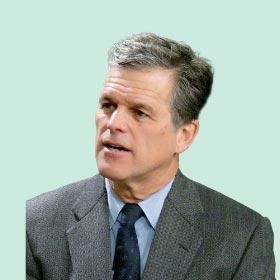
"I'm constantly looking for how do we craft a new narrative that fits. Maybe we're missing just one little piece."
Timothy Shriver, Ph.D. Chairman of Special Olympics
02 Developing Leadership Skills: How to Be a Better Leader
- The first step to becoming a better leader is understanding your natural talents and developing them into strengths.
- Leaders should meet their followers' core needs: trust, compassion, stability and hope. When leaders deliver on these, they build loyalty and inspire performance.
A good leader takes responsibility for their leadership. They understand that everything they do directly affects the people they lead.
In other words, the best leaders lead with their followers in mind.
And one of the most important leadership traits is engaging your followers.
We've studied which leadership skills are the most important to a follower. What do you think we found? Maybe "good communication," "motivational" or "highly committed"?
While these are certainly important for leaders, what followers crave the most are trust, compassion, stability and hope.
Check out the descriptions below. Which one of these areas do you excel in? Which one doesn't come as naturally to you, and how can you lean on strong complementary partnerships for that need?
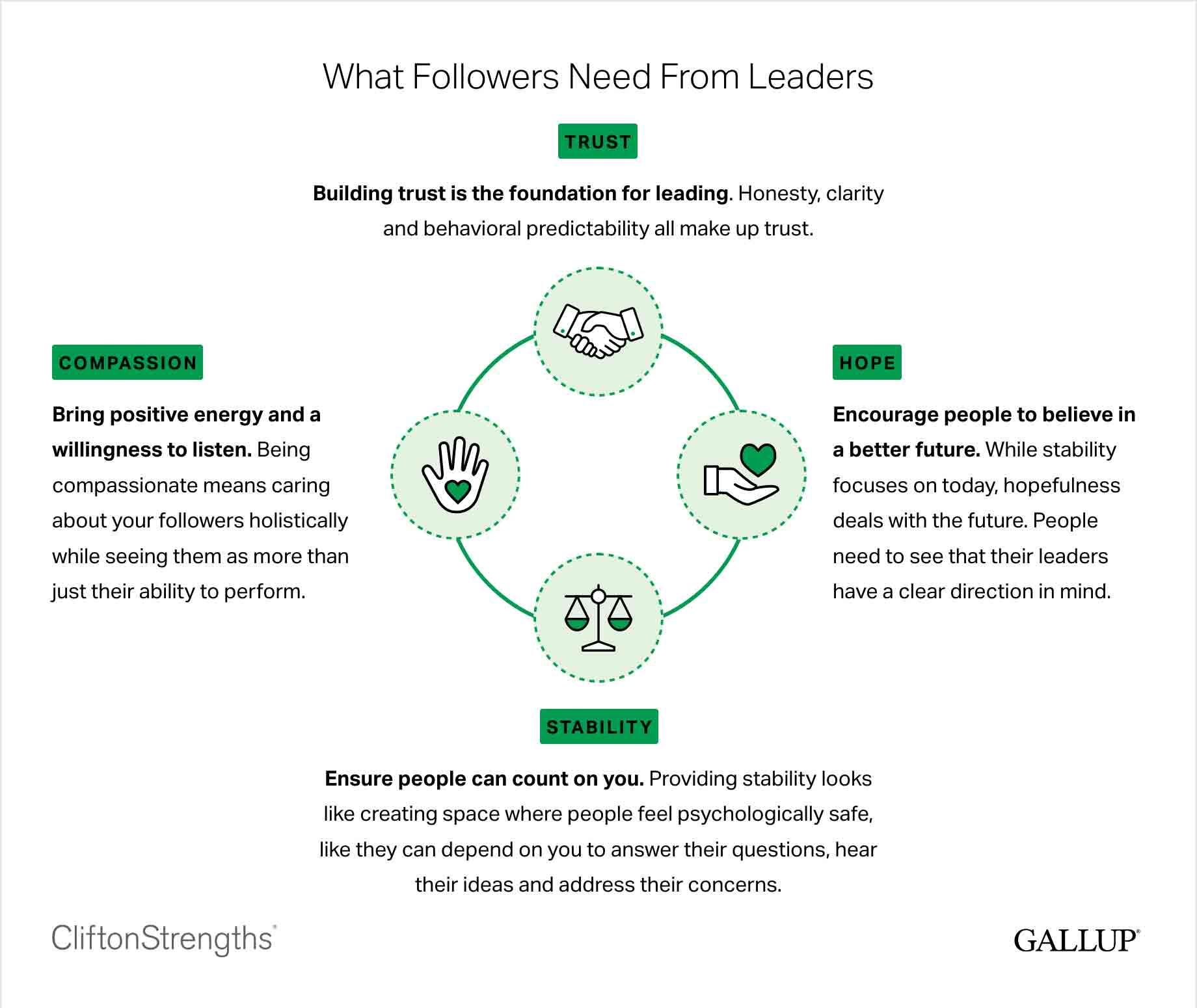
Chart depicting what followers need from their leaders. Trust - Building trust is the foundation for leading. Honestly, clarity and behavioral predictability all make up trust. Hope - Encourage people to believe in a better future. While stability focuses on today, hopefulness deals with future. People need to that their leaders have a clear direction. Stability - Ensure people can count on you. Providing stability looks like creating space where people feel psychologically safe, like they can depend on you to answer their questions, hear their ideas and address their concerns. Compassion - Bring positive energy and a willingness to listen. Being compassionate means caring about your followers holistically while seeing them as more than just their ability to perform.
To practically apply these traits, make them a part of your everyday communication. Every email, conversation, instruction, etc., should be building hope, trust, stability and compassion.
Learn more about these traits of a good leader (also called the "four needs of followers") from Gallup experts.
03 Seven Expectations for Leaders
03 Seven Expectations for Leaders
Gallup identifies seven core expectations for leadership:
- Build relationships.
- Develop people.
- Lead change.
- Inspire others.
- Think critically.
- Communicate clearly.
- Create accountability.
These expectations form a practical framework for what leaders should focus on every day to drive performance and success — in any environment, whether it's the boardroom, the classroom or a book club.
Why These Seven Expectations Matter
If you’ve ever Googled terms like "effective leadership skills," "best leadership qualities" or "qualities of a good leader," you’ve likely seen advice centered on fixing weaknesses or adopting traits that may not come naturally. That approach often leads to frustration and burnout.
Instead, great leadership begins with self-awareness — knowing your strengths and understanding what your role requires. From there, you can focus on applying your natural talents to these seven leadership expectations to create real, lasting impact.
Applying the Seven Expectations for Leaders
Here’s how to bring each expectation to life in your leadership role:
- Build relationships.
Leadership starts with connection. People won’t follow you if they don’t trust you. Recognize the value of others, get to know them as individuals, and build authentic, lasting relationships.
- Develop people.
Are the people you lead growing? Development should be constant. Whether in an office or a fitness class, when people feel they’re progressing, they’re more engaged — and more likely to stay.
- Lead change.
The key word here is “lead.” You’re responsible for pushing forward while keeping the mission and vision in focus. Invite your team into the change process so they own the outcome with you.
- Inspire others.
Inspiration isn’t soft — it’s essential. Leaders must help people find meaning in their work. That sense of purpose fuels motivation and commitment to something bigger than themselves.
- Think critically.
Strong leadership demands sharp thinking. Evaluate risks, organize thoughts, and develop actionable plans. Avoid reactive decisions — instead, lead with clarity and intention.
- Communicate clearly.
Clear communication isn’t just about talking. It’s about sharing information in a way that drives understanding, decision-making and trust. Learn how others best receive information, and adapt.
- Create accountability.
A culture of accountability starts with the leader. Be clear about commitments and follow through. When you take ownership, it empowers your team to do the same — and to thrive.
Whether you’re a CEO, professor, volunteer leader or coach, these seven expectations are universal. Practicing them consistently is what sets great leaders apart from average ones — no matter the context.
04 How to Be an Effective Leader
04 How to Be an Effective Leader
- Know and lead with your strengths to bring authenticity to your leadership.
- Set a clear vision and help your team connect their work to it.
- Foster a culture of engagement and accountability.
- Coach team members regularly and recognize their contributions.
You may have wondered, "What type of leader am I?"
There are countless ways you could answer this question. But most people look to academic leadership theories or find a list of leadership personality traits and different leadership styles to try to answer this.
For example, there's transformational leadership or authentic leadership. Well, wait, aren't all leaders supposed to be these two things? Then there's transactional leadership and laissez-faire leadership, or you could be more autocratic or a coaching leader. OK, now I'm really confused.

With many ways to pinpoint your leadership styles or categorize your relationships with your followers, your attempts may leave you feeling discouraged or irritated. But if you're not sure what kind of leader you are, how are you supposed to find support or improve?
Instead, ask yourself a different question: Why and how do I lead?
Most leadership categories are all about how a person behaves when they're leading a group — when really, you should be focusing on the things that you already know and that are easier to identify: your natural patterns of excellence. These natural strengths tell you more about why you lead the way you do and how you lead best than about what kind of leader you are.




Each leader is naturally drawn to different things, so you may find that more traditional ways of compartmentalizing leadership styles leave you feeling confused. Instead, answer the questions presented by the four domains of leadership below.
![]() Traditional "Choose One" Leadership Styles
Traditional "Choose One" Leadership Styles
Traditional methods of leadership discovery say to choose the statement that best describes you to discover what one specific type of leader you are.
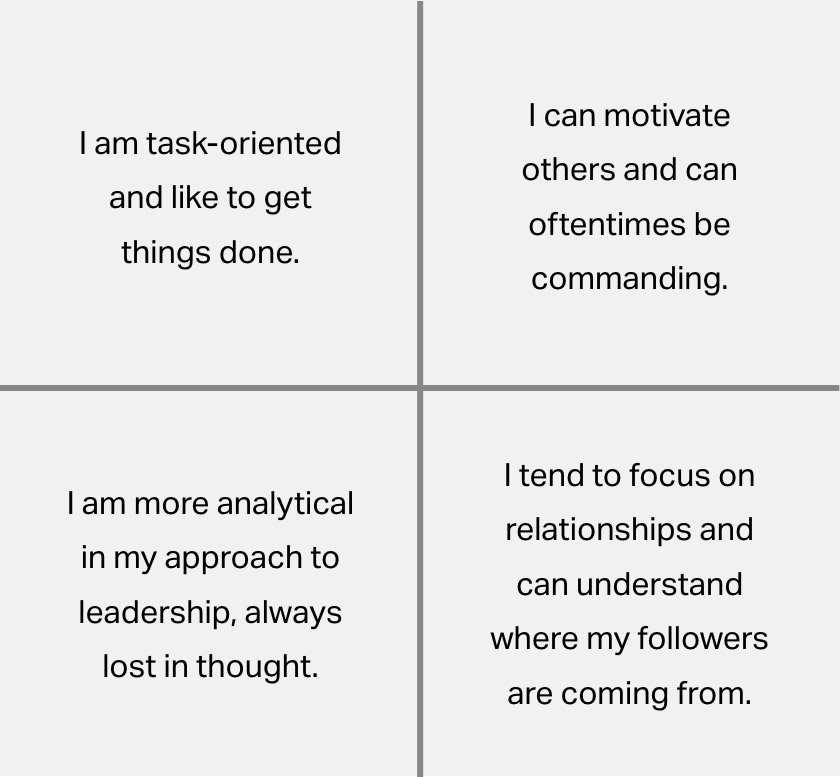
Top Left Quadrant: I am task-oriented and like to get things done. Top Right Quadrant: I can motivate others and can often be commanding. Bottom Left Quadrant: I am more analytical in my approach to leadership, always lost in thought. Bottom Right Quadrant: I tend to focus on relationships and can understand where my followers are coming from.
![]() Four Domains of Leadership
Four Domains of Leadership
The four domains of leadership say, "You naturally do all of these things; you just do them differently than others. Let's discover your unique way of leading."
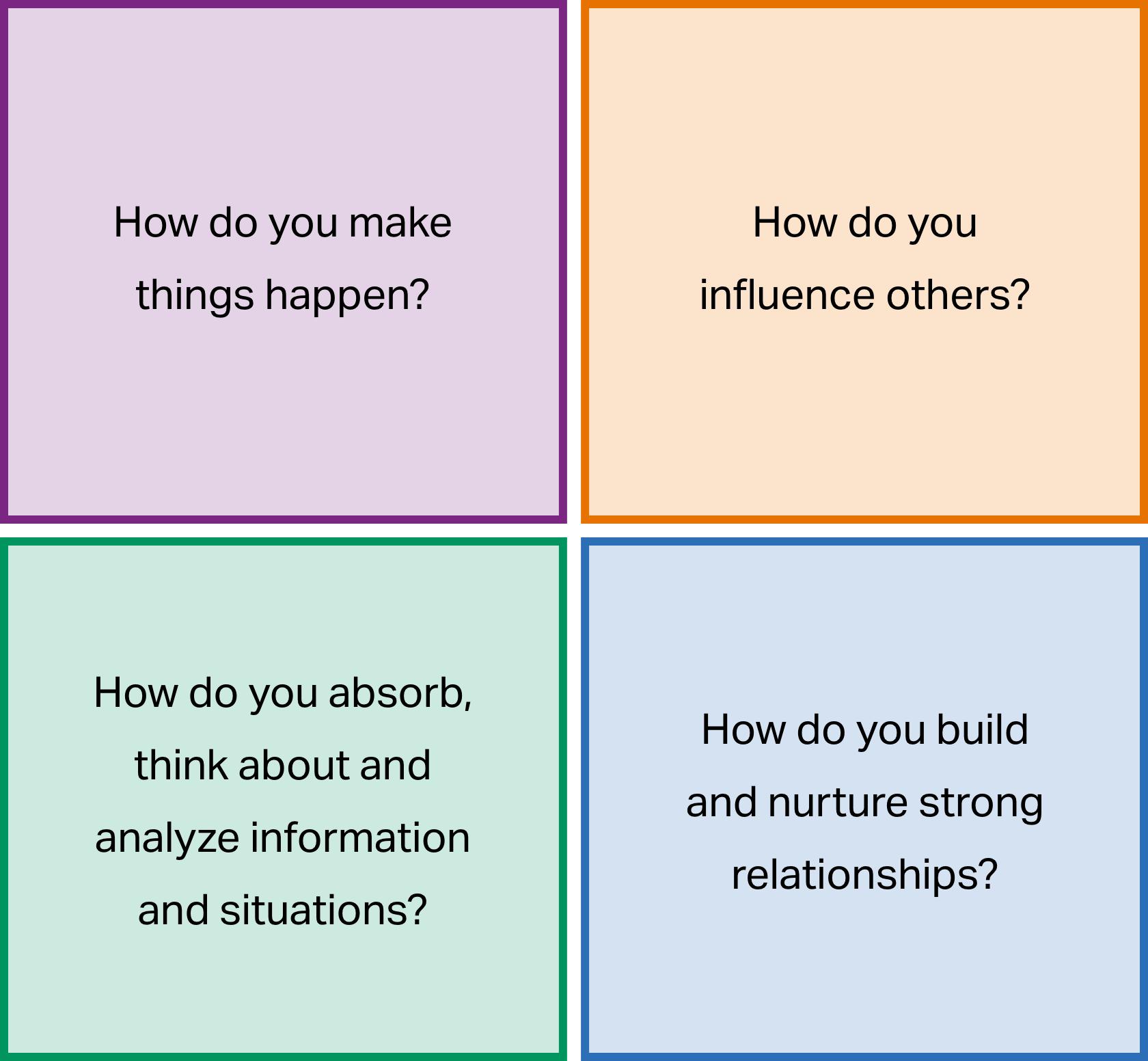
Top Left Quadrant: How do you make things happen? Top Right Quadrant: How do you influence others? Bottom Left Quadrant: How do you absorb, think about and analyze information and situations? Bottom Right Quadrant: How do you build and nurture strong relationships?
The four domains of leadership are a helpful framework because when you search for one specific leadership style, you wind up trying to spend more time categorizing than you do developing.
Traditional leadership styles establish strict boundaries, but the CliftonStrengths domains freely encourage you to cross those boundaries.

Use this guide to help you determine your leadership style with CliftonStrengths.
Each of the four domains encompasses a set of CliftonStrengths that fit that category. Leaders who know their CliftonStrengths become more effective leaders in a few ways. Knowing their strengths helps them:
- improve their decision-making
- boost their engagement
- increase their productivity
Simply understanding your strengths makes your life better — and who wouldn't want to have a higher quality of life and be more effective? Haven't discovered your strengths yet? Get started and take the assessment today.
05 Leadership vs. Management
At the end of the day, leaders and managers are both focused on two things: developing people and delivering team (or organizational) success.
Leadership: Traditionally, leaders have been responsible for creating the overall strategic vision.
Management: Managers are the ones who execute leadership direction and direct teams.
But as the workplace continues to change, the line between the roles of leaders and managers continues to blur.
Driven by the pace of change in globalized business and an evolving workforce that prioritizes development and flexibility, today's business world is agile and dynamic. As a result, a manager's role is far more than supervisory — and Gallup finds that 70% of the variance in a team's engagement is influenced by the manager. Furthermore, the traditional role of a boss as a command-and-control function does not work for today's workforce.
The expectation is for the manager and leader to be more of a coach than a boss.
- My Paycheck
- My Satisfaction
- My Boss
- My Annual Review
- My Weaknesses
- My Job
- My Purpose
- My Development
- My Coach
- My Ongoing Conversations
- My Strengths
- My Life
The biggest difference between a leader and a manager is where they fall within an organization. A manager is someone who is usually in charge of leading people, where a leader is in charge of leading the people who lead people. Leaders are more responsible for creating the strategic vision and are a little more removed from the front lines. Managers are more about getting the actual work done.
06 What Makes a Successful Team?
06 What Makes a Successful Team?
- Align team members' roles with their strengths for higher engagement.
- Set clear expectations and create an environment of trust and collaboration.
- Provide regular coaching and recognition to build motivation.
- Encourage open communication and continuous improvement.
Success is measured and defined differently by all, which means that good information on how to lead your team to success or understanding what makes a successful team can be hard to find. Before you know how to lead, you need to know what a successful team looks like.
A successful team is a team where individuals are positioned to do what they do best and get the resources and partnerships they need to do their best work.
Leading a successful team requires you to identify the unique contributions that every person on your team makes — including yourself.
CliftonStrengths makes this easier. Having team members discover, develop and lead with their strengths can lead to higher employee engagement and performance, which are outcomes of a successful team. However, they aren't the most important outcomes because giving your employees the opportunity to do what they do best is the greatest measure of a successful team.
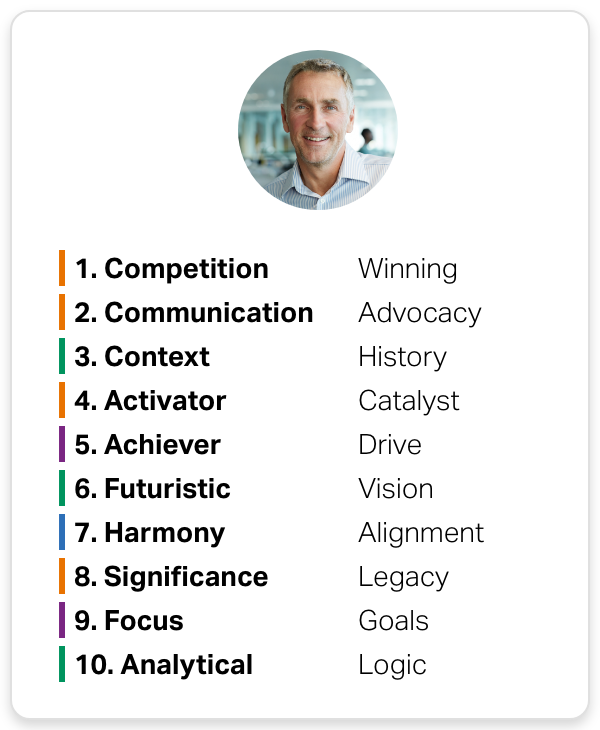
Competition - Winning. Communication - Advocacy. Context - History. Activator - Catalyst. Achiever - Drive. Futuristic - Vision. Harmony - Alignment. Significance - Legacy. Focus - Goals. Analytical - Logic.

Harmony - Alignment. Arranger - Orchestration. Maximizer - Excellence. Relator - Transparency. Input - Resources. Includer - Connection. Analytical - Logic. Positivity - Optimism. Intellection - Reflection. Consistency - Fairness.
To lead a successful team, be willing to admit to your team that you're not great at everything. It's good to acknowledge, and it's even better for your team to hear.
Conventional wisdom says that to become a better leader, you should develop the areas where you are naturally weak. And to be a good leader, you encourage your team to do the same. But CliftonStrengths says you should invest in the places where you're naturally strong.
"Identify the unique contributions that every person on your team makes — including yourself."
Here's a practical way for you and your team to understand each other's strengths and intentionally aim them at your goal — the CliftonStrengths Team Grid.
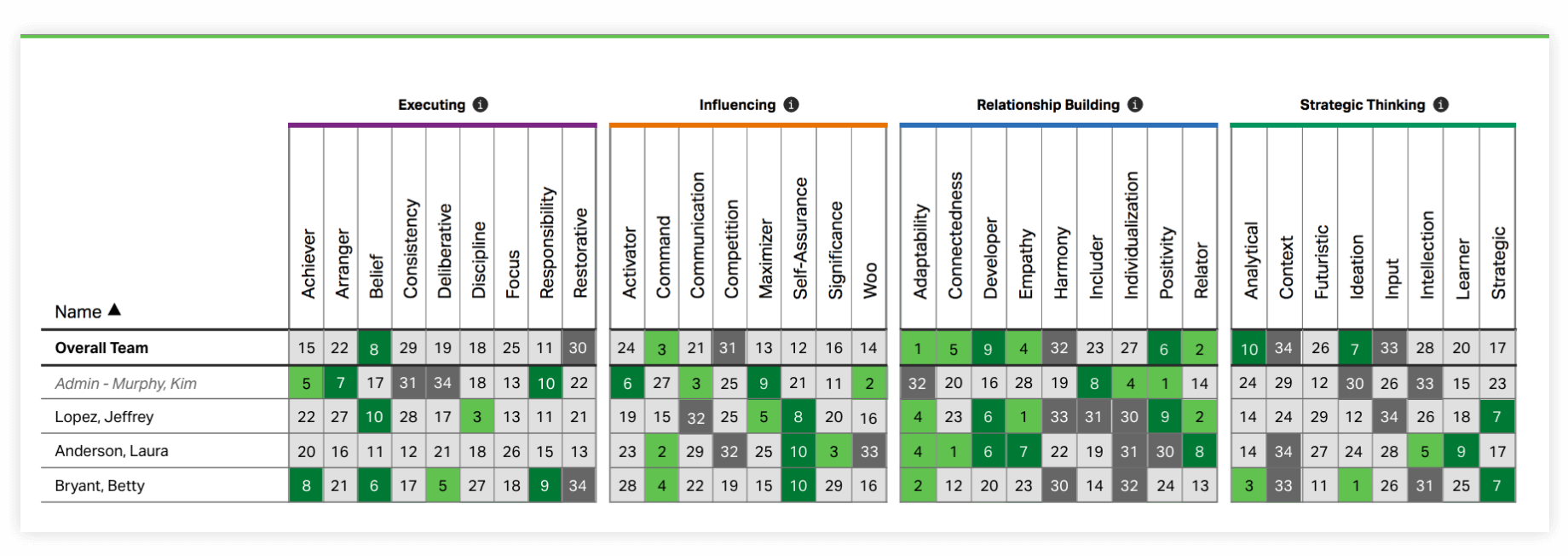
As a leader, you could look at your team's grid to determine who would be good partners to:
- come up with ideas for a new solution to a process
- determine how to make an existing process more efficient
- help gather the latest findings in your industry and analyze them
Knowing the makeup of your team's strengths allows you to lead more confidently because you know how to set each person up for success.
Position individuals to do what they do best, better use each individual's strengths, build more effective partnerships and teams, and then mobilize the team to increase individual and team effectiveness.
For more information about the team grid and bringing strengths to your team, contact us.
07 Creating a Leadership Development Plan
07 Creating a Leadership Development Plan
- Start with a strengths assessment like CliftonStrengths for Leaders to identify your leadership potential.
- Download Gallup's 7 Expectations for Leaders activity to reflect on the leadership competencies you excel at.
- Learn to identify your own key experiences, both the ones that got you where you are today and the ones you want to have.
If your attempts to develop in the past have fallen short, it may be because too few leadership development programs can clearly define the experiences that lead to excellence in leadership. They don't individualize, they can't match leader to experience at the time it's most needed, and they don't help leaders analyze their experiences so they can effectively apply them in the future.
Don't overcomplicate your development. Start with these three areas:
1 We believe that knowing your strengths is a great foundation for creating a leadership development plan. When you take the CliftonStrengths assessment, you will get a report with personalized results. Discover your natural talents, and then receive the CliftonStrengths for Leaders report with insights and advice based specifically on your results to help you become a better leader. The descriptions of your top strengths, and the order in which they appear, will be unique to you. Because just as we believe that no two leaders lead the same way, we also believe that no two people have the same strengths.
The descriptions of your top strengths, and the order in which they appear, will be unique to you. Because just as we believe that no two leaders lead the same way, we also believe that no two people have the same strengths.
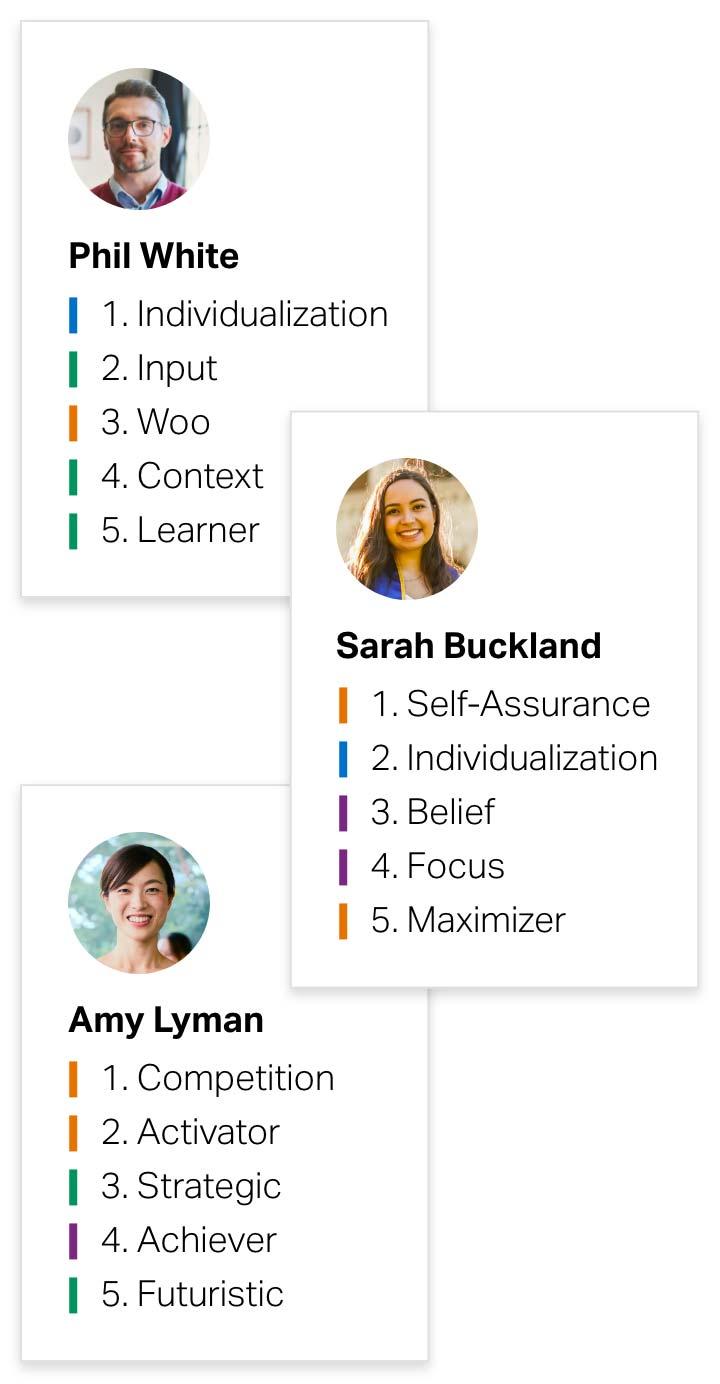
2 Take a look at the seven expectations for leaders. If you truly want to develop, those are where you should begin. Start with a self-assessment. At first glance, which one of these core leadership competencies do you do really well? How can you get even better? Then determine which one doesn't come as naturally. How can you use your natural strengths to develop it?
- 1. Build relationships.
- 2. Develop people.
- 3. Lead change.
- 4. Inspire others.
- 5. Think critically.
- 6. Communicate clearly.
- 7. Create accountability.
For more details, check out the Seven Expectations for Leaders section. And to get started right now, download this free activity to help you develop.
3 Learn to identify your own key experiences, both the ones that got you where you are today and the ones you want to have. Consider your past and present, and decide what you want for your future. Key experiences are some of the most critical components of leader success. Put simply, "Key experiences are events in a leader's life that result in learning, growth and/or increased capacity to effectively lead." Every role and every industry looks different, but key experiences are one of the foundational elements to leadership development anywhere.
Here are a few examples of key experiences that have helped develop leaders in the workplace:
- working on stretch assignments and projects outside of their expertise
- turning around a failing business or product
- leading a cross-functional team on a mission-critical organizational project
- experiencing failure and learning from it
Although those key experiences will look different for each person, you can notice a pattern or commonality between them all. Embracing new situations and being uncomfortable are important parts of developing as a leader. When things look tough, lean in. That's where growth happens.
08 Our Best Leadership Resources
08 Our Best Leadership Resources
Your time is best spent when you're sharpening your skills and honing your talents. Stop worrying about what you're bad at, and start working harder at developing what you're good at.

